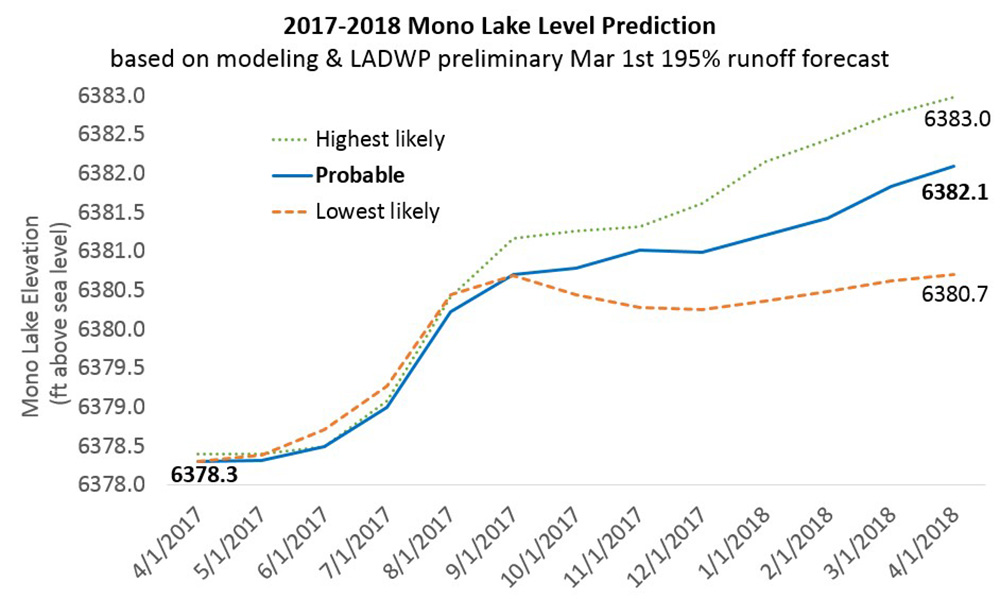
Last week the Los Angeles Department of Water & Power (DWP) released its preliminary runoff forecast based on record-breaking March 1st snow surveys: 195% of average runoff for the April 1, 2017 through March 31, 2018 runoff year. This volume of runoff is very similar to 1983, the wettest runoff year on record. Due to the warm storms in January and February, the lower-elevation snowpack below about 9,000 feet above sea level is much lower than in 1983, so we are assuming that record runoff is a high-end scenario. That forecast also assumes median precipitation over the next year.
Based on 1983 as a high end, 1995 as a probable scenario, and 2006 as a lowest possible scenario, we modeled the likely rise in Mono Lake based on those past year inflows and probable reservoir operations this year. The result? A 3.8-foot rise in Mono Lake is likely over the next year. Expected Grant Lake Reservoir operations add about half a foot to our forecast.

All three scenarios have little or no rise before May and a similar rise in May and June, since snow can only melt so fast, and Grant Lake Reservoir isn’t likely to spill prior to mid-June. Larger snowpacks tend to melt more slowly and vice versa, therefore the lowest annual rise has the fastest spring rise. The three scenarios diverge by September, with a likely rise between 2.4 and 2.8 feet by then. This would be at least a 3-foot increase over last September! This rapid influx of fresh water will almost certainly prevent Mono Lake from mixing this fall and will lower the biological productivity of the lake during the next few years. This may return the lake’s summer clarity to historic levels—the lake failed to clear during the last three summers.
You can see the current level of Mono Lake here, and download a PDF of our Mono Lake level forecast here. We will continue to update this forecast as new information becomes available each month. The April forecast is usually quite good, but April can be wet so the final runoff forecast isn’t released until May, when DWP will also issue a lake level forecast.
June can also be wet. Last year NASA’s Airborne Snow Observatory (ASO) Program sent us snowpack data within two days of their aerial surveys as the snowpack melted in June. Already this week we received snowpack data for Lee Vining Creek from ASO, and it confirms that the snowpack drops off significantly below 9,000 feet.
This potential four-foot rise in Mono Lake is very exciting, and would return Mono Lake to where it was during the first year of the five-year drought!

Would the potential 4-foot rise cause Mono Lake to be considered “full”?
Debra – no, far from it. Mono Lake’s pre-diversion level in 1941 was 39 feet higher than it is now! Today’s natural level would be close to that. The future management level of 6392 feet above sea level is still 14 feet higher than now, and will be about 10 feet higher than next year’s April 1st level. Thanks for the question, those are important points I left out!
Yes, the 4-foot rise will be wonderful, but people need to know that Mono Lake should naturally be another 35 feet higher than that. What a magnificent specimen she would be at that level!
If Mono Lake were ever to return to its original levels, how would that change the salinity and/or productivity of the lake in providing food for other wildlife?
Hi Wendy, if that happened, Mono Lake’s salinity would decrease, which would increase the productivity of alkali flies and brine shrimp. Both of those are important food sources for many species of birds, so the birds would have more available food. As far as other wildlife, we really don’t know—no one was studying the ecological productivity of Mono Lake in the 1930s before diversions began. However, it’s important to note that Mono Lake will not return to its original levels—the State Water Board’s decision from 1994 specifies that most water go to Mono Lake, and that some water always go to Los Angeles.
It was my understanding that the Committee had collected at least $10,000 for the Gull Protection fence by the end of 2016. Is the total cost for the fence approximately $15,000? If so, I am surprised that the Committee did not receive enough donations to complete the fence prior to this last minute fund raising effort to meet the March 28 deadline.
Thanks, Elin, very interesting! I feel very grateful that people stepped in before the lake disappeared. There were still lots of flies when I was there the last time, so I imagine it’ll only get better as time goes on if we don’t have any more five-year droughts.